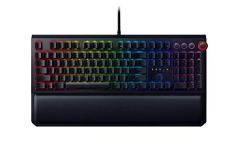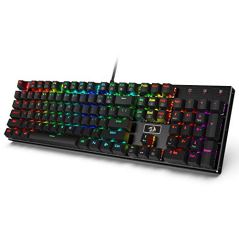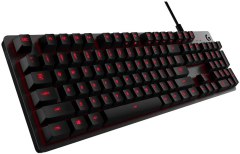
Precise, comfortable, and endlessly customizable, this mechanical keyboard is the perfect fit for a high-end gaming rig.
Precise, comfortable, and endlessly customizable, this mechanical keyboard is the perfect fit for a high-end gaming rig.
This tournament-ready keyboard equips tactile (and clicky) green switches requiring just 50 grams of actuation force. It's customizable with its 16.8 million-color Chroma lighting system and macro capabilities. Each key can be remapped to execute different commands. Magnetic wrist rest, media keys, and convenient volume wheel. Available with linear and quiet yellow switches.
Razer's Synapse software, which controls Chroma lighting and macros, isn't always intuitive to use.

If you need premium tactile keystrokes under your fingers, the inexpensive Alloy Origins mechanical keyboard likely has a setup that you will appreciate.
If you need premium tactile keystrokes under your fingers, the inexpensive Alloy Origins mechanical keyboard likely has a setup that you will appreciate.
Fairly priced. Compact keyboard. Adjustable stand angles. Vivid customizable RGB lighting. Available with tactile, linear, and clicky keys. Rugged aluminum body.
Buyers should research which key type is their preference before buying.

This durable mechanical keyboard is far more customizable and reliable than you may expect for its low price point.
This durable mechanical keyboard is far more customizable and reliable than you may expect for its low price point.
Affordable. Accurate and durable keys. Rugged brushed aluminum frame. Includes a range of RGB lighting presets and customizable options. Dedicated gaming mode.
Not the quietest keyboard available.

While it may not have as many features as pricier options, this cheap yet durable model is a well-designed entry level model that PC gamers will enjoy.
While it may not have as many features as pricier options, this cheap yet durable model is a well-designed entry level model that PC gamers will enjoy.
Especially affordable. Precise backlit keys. Durable brushed-aluminum frame. Features a USB port. Swappable gaming keycaps. Quiet keystrokes. Dedicated gaming mode.
Its lighting is permanently set to cherry red.

If it seems as though lesser models cannot withstand your hardcore typing and gaming, this ultra-rugged mechanical keyboard is your best bet.
If it seems as though lesser models cannot withstand your hardcore typing and gaming, this ultra-rugged mechanical keyboard is your best bet.
Extremely durable keys and metal frame. Bright customizable RGB backlit keys. Features six macro keys. Soft wrist rest. Quiet keystrokes. Volume control. Available in three types of keys.
You should research if silver, brown, or blue keys are your preferred tactile experience before buying.

We recommend these products based on an intensive research process that's designed to cut through the noise and find the top products in this space. Guided by experts, we spend hours looking into the factors that matter, to bring you these selections.

Once upon a time, mechanical keyboards were the rule rather than the exception. If you had a computer prior to the 1990s, chances are good that it came with a mechanical keyboard. The less expensive rubber dome keyboards took off in that decade and now account for 90% of all keyboards produced.
Why would you buck this trend and purchase a mechanical keyboard? By definition, mechanical keyboards are made up of switches that actuate before the switch bottoms out. They provide a consistent feel that is prized by typists and gamers alike. Mechanical keyboards are also more durable than their rubber dome or membrane cousins, frequently built with switches that are rated in the millions of presses. While more expensive, this durability will more than pay for itself when your keyboard is still clicking away years later.
When shopping for a mechanical keyboard, what features and other considerations should you keep in mind? While mechanical keyboards are similar to the more popular membrane keyboards, there are still several factors to consider.

Mechanical keyboards come in a variety of sizes and layouts. Some of the more popular include the following:
Full-size: This is the traditional or standard layout that you’re probably accustomed to. The U.S. standard for these is 104 keys, and it’s notable for the inclusion of a full number pad. Some typists may find these to be hard to use or too large.
Tenkeyless: The tenkeyless, or 80%, keyboard essentially just omits the number pad, resulting in 87 keys (U.S.). If you use the number pad infrequently or not at all, this might be a more ergonomic option for you.
60% and 75%: Both of these mechanical keyboards either shrink the function and arrow keys on the right or delegate them outright to a function layer. Neither of these has a number pad.
When mechanical keyboards are mentioned, switches invariably spring to mind. When you press a key on a mechanical keyboard, you’re really pressing a switch. One of the features that’s unique to mechanical keyboards is the variety of switches available and the different feel of each one.
Most of the switches you’ll find today are Cherry or Cherry clones, and you can find them in a variety of color options that largely break down into three unique types:
Clicky: These switches feature a crisp feel and clicking noise that is prized by those who type often. Cherry MX Blue is a common clicky switch, while MX Green is also popular.
Tactile: These offer less of a clicky feel in addition to producing less noise. These are great switches for people who type frequently and don’t want to deal with the noise of a clicky switch. Cherry MX Brown and MX Clear are popular tactile switches.
Linear: These switches are quite responsive and offer little resistance when you push them. They can be more difficult to type with but are highly prized by gamers due to the speed with which you can press them. Common linear switches include Cherry MX Red and MX Black.
Mechanical keyboards are more durable than membrane keyboards, but some mechanical keyboards are even more rugged than others. Search for a keyboard that features a casing made of aluminum or other strong material for increased durability. If you have a habit of spilling coffee or other liquids around your computer, seek out a keyboard that’s water resistant.

Lighting
Some typists prefer backlit keys for a variety of reasons. If you are one, keep this feature in mind when comparing keyboards.
Some keyboards take backlighting to the next level with programmable LED lighting. While certainly not a necessary feature, it can be a fun one. Keyboards that have LED lighting usually have bundled software to control or program the light patterns on the keyboard. Gamers may find this feature to be a must-have because they can download profiles that work with their favorite games (think flashing red and blue lights when the police are closing in while playing Grand Theft Auto).
Cable
The cable that ships with your mechanical keyboard may attract little notice, but without it your keyboard is pretty much just a paperweight. The included cable should be long enough to work with your setup. It should also be durable. Braided cords will generally be more rugged than non-braided ones.
Some keyboards have a detachable cable, while others feature USB or audio pass-through ports so you can plug a mouse or headset directly into the keyboard.
Programmability
Are you the kind of typist who loves to rearrange keys and program custom layouts? Then be sure that your keyboard supports this level of tinkering. Also note any dedicated macro keys or multimedia keys that the keyboard is equipped with if you have an interest in those.

As we’ve noted, mechanical keyboards are not all that economical. This is one area where paying more is recommended because you’ll wind up with a longer-lasting keyboard with higher-quality switches. That said, you should be able to pick up a decent quality keyboard starting at around $30, although most run in the $50 to $100 range. The price goes up from there for keyboards with more advanced features or ergonomic designs.

Q. Can I build my own mechanical keyboard?
A. If you’d rather try your hand at building a mechanical keyboard instead of buying one, there are DIY kits. This a great way to set up your keyboard with your favorite switches or switch combos.
Q. Which switch is best for an office setting?
A. The tactile MX Brown or MX Clear switches are perfect for office situations. They offer excellent typing without the noise of a more clicky switch.
Q. Will these work with both a PC and a Mac computer?
A. Read the product description carefully. Some of these are specific to either a PC or Mac, while others will work with both (although you might need to rearrange the keyboard some so it will work with your system).
Get emails you’ll love.
Learn about the products you’re wondering if you should buy and get advice on using your latest purchases.
